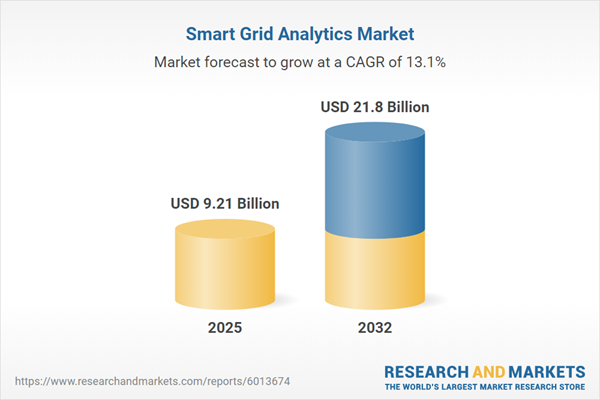Speak directly to the analyst to clarify any post sales queries you may have.
As utilities navigate accelerating digital transformation, smart grid analytics provides a proven pathway for enhancing operational resilience and regulatory compliance. Executives prioritizing modernization find that advanced analytics unlock new capabilities for infrastructure reliability, informed risk management, and strategic advantage within evolving market landscapes.
Market Snapshot: Smart Grid Analytics Market
The smart grid analytics market is projected to reach USD 21.80 billion by 2032, increasing from USD 8.15 billion in 2024, with a compound annual growth rate (CAGR) of 13.08%. This robust market growth is fueled by sustained investments in digital infrastructure, evolving regulatory standards, and the increasing integration of distributed energy resources. Utilities are deploying analytics to improve infrastructure performance, enable real-time operational insight, and address emerging challenges around compliance and modernization priorities. As competition intensifies, the ability to efficiently align technology with business processes is distinguishing leading market players.
Scope & Segmentation
- Application Areas: Asset performance management supports predictive maintenance and higher reliability for critical grid segments such as substations and transformers. Demand response management allows flexible load control for commercial, industrial, residential, and microgrid users, adapting to consumption trends and system needs. Distribution management optimizes network operations through real-time oversight and advanced voltage regulation, anticipating faults before they escalate. Energy theft analytics leverages data from advanced metering to identify and address unauthorized usage. Outage management accelerates fault detection and restoration workflows. Network analytics underpins forecasting and planning, ensuring power quality and capacity are maintained.
- Component Types: Services encompass consulting, integration, and technical support to facilitate adoption across the analytics lifecycle. Software platforms incorporate analytics engines, geospatial systems (GIS), SCADA integrations, mobile access interfaces, and data visualization tools, enabling actionable insights and transparency.
- Deployment Modes: Options span hybrid, private, and public cloud, as well as on-premise setups. These choices allow utilities to meet distinct regulatory obligations, cybersecurity requirements, and existing technology stack preferences within their footprint.
- End Users: Cooperative utilities emphasize collective asset management and resource pooling. Investor-owned utilities prioritize infrastructure performance and cost management. Public power and municipal providers focus on maintaining resilient local distribution, while transmission entities ensure system-wide grid stability and regional collaboration for seamless energy delivery.
- Geographic Regions: Implementation strategies vary based on regional regulation and technological maturity. North America, South America, EMEA, and Asia-Pacific each exhibit unique adoption drivers, with heightened momentum in the US, Canada, Brazil, UK, Germany, China, India, Japan, Australia, and South Korea. Utilities in each region tailor deployment to align with local modernization goals and compliance demands.
Key Takeaways: Smart Grid Analytics Market
- Integrated analytics platforms enhance situational awareness, break down information silos, and facilitate end-to-end operational visibility for efficient grid management.
- Machine learning capabilities advance predictive asset maintenance and streamline integration of distributed energy resources, empowering utilities to make informed lifecycle decisions.
- Standardized architectures support scalable demand response and robust grid control, maintaining power quality benchmarks as new technologies are integrated.
- Flexible cloud and on-premise solutions strengthen cybersecurity and foster efficient collaboration between stakeholders, supporting broad operational environments.
- Continual innovation is required as regulatory frameworks and compliance mandates drive market customization and influence technology roadmaps for analytics providers.
- Strategically embedding analytics within business processes improves agility and strengthens adaptability as the regulatory and technological landscape evolves.
Tariff Impact
Recent tariffs introduced in the United States are prompting utilities and their partners to reassess sourcing and procurement strategies. Diversification of supplier networks and stronger partnerships with local or nearshore vendors are increasing in strategic importance as utilities seek to counter rising input costs. In response, many organizations are adopting software-driven, modular solutions designed for adaptability, while vendors are emphasizing hardware-agnostic configurations to future-proof utility infrastructure against regulatory changes.
Methodology & Data Sources
This report synthesizes insights collected through direct interviews with senior decision-makers at utilities, technology vendors, and systems integrators. These primary perspectives are augmented by robust technical analysis, anonymized market datasets, and up-to-date regulatory records. Findings are subjected to impartial peer review to ensure quality, accuracy, and objectivity.
Why This Report Matters
- Delivers proven frameworks for executives seeking to balance modernization investment with minimized risk, empowering informed, strategic decisions in dynamic regulatory environments.
- Provides actionable benchmarks and assessment criteria for analytics platform evaluation, partner selection, and streamlined procurement processes.
- Equips utility organizations with best-practice guidance for resilient and effective deployment, driving measurable outcomes in network efficiency, stakeholder collaboration, and grid modernization.
Conclusion
Smart grid analytics delivers the actionable intelligence executives need for digital evolution and reliable distributed energy integration. Strengthening organizational analytics capabilities will be essential for sustained performance and adaptability as the global power sector transforms.
Additional Product Information:
- Purchase of this report includes 1 year online access with quarterly updates.
- This report can be updated on request. Please contact our Customer Experience team using the Ask a Question widget on our website.
Table of Contents
3. Executive Summary
4. Market Overview
7. Cumulative Impact of Artificial Intelligence 2025
Companies Mentioned
The companies profiled in this Smart Grid Analytics market report include:- General Electric Company
- Siemens AG
- International Business Machines Corporation
- Schneider Electric SE
- Honeywell International Inc.
- ABB Ltd
- Oracle Corporation
- Itron, Inc.
- Landis+Gyr AG
- Cisco Systems, Inc.
Table Information
| Report Attribute | Details |
|---|---|
| No. of Pages | 197 |
| Published | October 2025 |
| Forecast Period | 2025 - 2032 |
| Estimated Market Value ( USD | $ 9.21 Billion |
| Forecasted Market Value ( USD | $ 21.8 Billion |
| Compound Annual Growth Rate | 13.0% |
| Regions Covered | Global |
| No. of Companies Mentioned | 11 |









